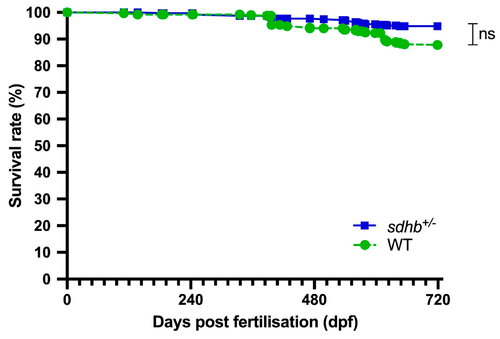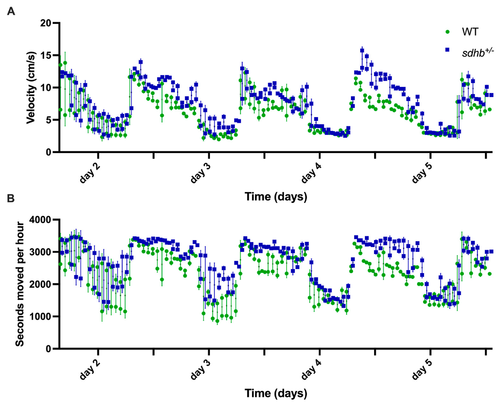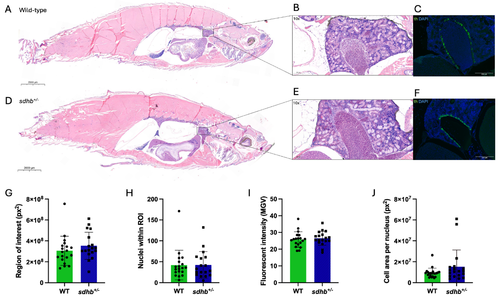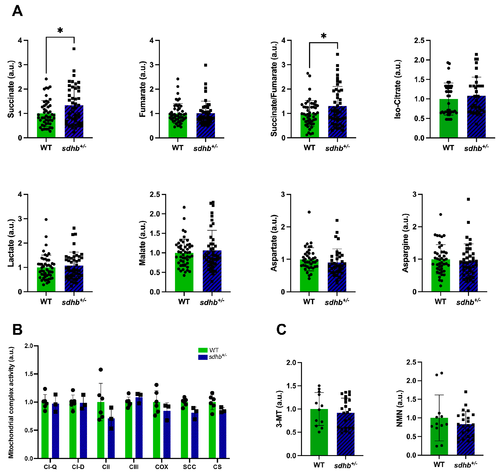- Title
-
Characterisation of an Adult Zebrafish Model for SDHB-Associated Phaeochromocytomas and Paragangliomas
- Authors
- Miltenburg, J.B., Gorissen, M., van Outersterp, I., Versteeg, I., Nowak, A., Rodenburg, R.J., van Herwaarden, A.E., Olthaar, A.J., Kusters, B., Conrad, C., Timmers, H.J.L.M., Dona, M.
- Source
- Full text @ Int. J. Mol. Sci.
|
Monitoring of adult heterozygous sdhb mutant and WT zebrafish. Survival in heterozygous sdhb mutants and WT zebrafish. No significant difference (p > 0.05) was observed in the survival rate (%) between heterozygous sdhb mutants (n = 288) and WT zebrafish (n = 385). Statistical significance was tested with a log-rank (Mantel–Cox) test. PHENOTYPE:
|
|
Behavioural analysis of adult heterozygous sdhb mutant (n = 5) and WT (n = 5) zebrafish. Swimming behaviour was tracked in two locomotor tests of 5 days. Ticks indicate 12-hour intervals. (A) Swimming velocity in centimetres per second. (B) Basal activity is displayed as cumulative seconds of movement. Basal activity was increased in heterozygous sdhb mutants during day periods (p < 0.05). There was no difference in swimming velocity between mutants and WT siblings during the day (p = 0.08) or night periods. The area under the curve (AUC) was used to evaluate statistical significance. PHENOTYPE:
|
|
General histology, kidney morphology, and chromaffin cell morphology of adult heterozygous sdhb mutant and WT zebrafish. (A,D) General histology of adult heterozygous sdhb mutant (n = 34) and WT (n = 35) zebrafish (Representative images; H&E staining, 0.8× magnification). (B,E) Head kidney morphology (H&E staining, 10× magnification). (C,F) Immunohistochemical staining of tyrosine hydroxylase in the head kidney of heterozygous sdhb mutant (n = 10) and WT (n = 9) zebrafish (10× magnification). (G–J) Quantification of tyrosine hydroxylase staining (ImageJ2). Student’s t test was used to evaluate statistical significance. No significant differences were found in any of the analyses. PHENOTYPE:
|
|
Metabolomics, mitochondrial complex activity, and metanephrine levels of adult heterozygous sdhb mutant and WT zebrafish. All values are standardised relative to the associated WT mean and expressed in arbitrary units (a.u.). (A) Abundance of metabolites in muscle tissue of heterozygous sdhb mutant (n = 44) and WT (n = 49) zebrafish (n is the total of three replicates). Succinate levels and succinate/fumarate ratios were significantly increased in heterozygous sdhb mutants compared with their WT siblings. (B) Mitochondrial complex activity in heterozygous sdhb mutant (n = 3) and WT (n = 6) zebrafish. Activity levels for all mitochondrial complexes were not significantly different. CI-D: complex I; CI-Q: quinone; CII: complex II; CIII: complex III; COX: complex V/cytochrome c oxidase; SCC: cytochrome P-450; CS: citrate synthase. (C) Catecholamine metabolite levels in the swimming water of heterozygous sdhb mutant (n = 23) and WT (n = 12) zebrafish. 3-MT: 3-Methoxytyramine; NMN: Normetanephrine. Student’s t test for metabolomics analysis and catecholamine metabolite analysis, Mann–Whitney U test for mitochondrial complex activity analysis. * p < 0.05. |




